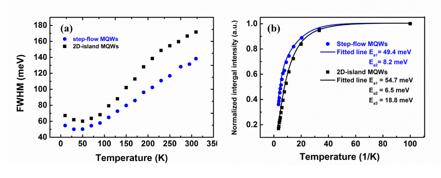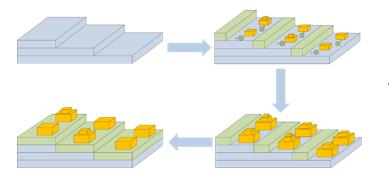The lower growth temperatures needed for high-indium-content InGaN reduces the diffusion distance of adatoms. Low-temperature growth with insufficient miscut leads to two-dimensional island or even three-dimensional growth, which can be indicated through increased surface roughness.
Green InGaN 4-period multiple QWs (MQWs) had x-ray diffraction (0002) peak full widths at half maximum (FWHMs) of 351arcsec and 381arcsec for 0.48° and 0.20° miscuts, respectively. The narrower peak suggests sharper well/barrier interfaces from the higher crystal quality achieved through step-flow growth.
Room-temperature photoluminescence (PL) peaks were observed at 2.313eV and 2.309eV for 2D island and step-flow MQWs, respectively . It is noted that the FWHMs of green MQWs with step-flow morphology are smaller than that of green MQWs with 2D island morphology at all temperatures, being 131 meV and 166 meV at room temperature, respectively.
The researchers comment: “The smaller FWHM value indicates better potential uniformity, which is beneficial for the improvement of the peak gain of green laser diodes and is believed to result partially from the sharper well/barrier interface, consistent with the XRD result. The indium composition homogeneity may also have improved as a result of the step-flow morphology, but this requires further study.”

Figure 2 (a) Temperature dependence of FWHM values of green MQW samples. (b) Normalized temperature-dependent integral PL intensity.(Image by SINANO)
Comparing the PL at 10K and room temperature, the internal quantum efficiencies (IQEs) were estimated at 30% and 15% for the step-flow and 2D island samples, respectively. The researchers attribute the IQE improvement for step-flow growth to “better material quality and fewer non-radiative recombination centers in the step-flow MQW sample”.
Temperature-dependent PL analysis suggested that a kind of non-radiative recombination centers with an activation energy of 18.8 meV could be eliminated, resulting into significant increase of IQE.
Laser diodes fabricated from these materials demonstrated the benefit of step-flow growth with reduced threshold current at 300mA, compared with 500mA for the 2D island laser diodes. The researchers attribute this reduction to the improved IQE for step-flow material.
This research has been published in Applied Physics Letters entitled “Significant increase of quantum efficiency of green InGaN quantum well by realizing step-flow growth”.
Contact Information:
Prof.LU Shulong, Suzhou Institute of Nano-Tech and Nano-Bionics, Chinese Academy of Sciences
Email: sllu2008@sinano.ac.cn
Reference:http://aip.scitation.org/doi/10.1063/1.5001185
downloadFile

